Å lage en effektiv medarbeiderundersøkelse handler ikke bare om å spørre «Er du fornøyd på jobb?» og avslutte dagen. De beste undersøkelsene avslører nøyaktig hvor teamet ditt trives – og hvor de stille og rolig trekker seg tilbake før det er for sent.
I denne omfattende veiledningen vil du oppdage hvordan du bygger engasjementsundersøkelser som faktisk driver endring, med over 60 velprøvde spørsmål organisert etter kategori, ekspertrammeverk fra Gallup og ledende HR-forskere, og praktiske trinn for å omsette tilbakemeldinger til handling.
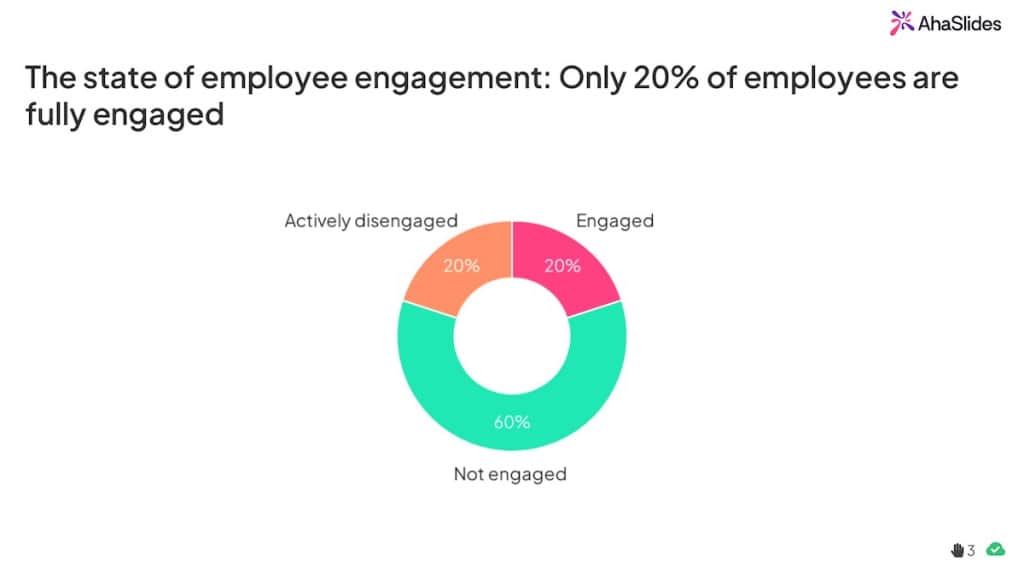
➡️ Rask navigering:
- Hva er en medarbeiderundersøkelse?
- Hvorfor de fleste medarbeiderundersøkelser mislykkes
- De tre dimensjonene av medarbeiderengasjement
- De 12 elementene for medarbeiderengasjement (Gallups Q12-rammeverk)
- 60+ spørsmål til medarbeiderundersøkelse etter kategori
- Hvordan utforme en effektiv medarbeiderundersøkelse
- Analysere resultater og iverksette tiltak
- Hvorfor bruke AhaSlides til medarbeiderundersøkelser?
- Vanlige spørsmål om medarbeiderundersøkelser
- Klar til å lage din medarbeiderundersøkelse?
Hva er en medarbeiderundersøkelse?
En medarbeiderundersøkelse måler hvor følelsesmessig engasjerte dine ansatte er i arbeidet sitt, teamet og organisasjonen. I motsetning til tilfredshetsundersøkelser (som måler tilfredshet), vurderer medarbeiderundersøkelser:
- Entusiasme for daglig arbeid
- Justering med selskapets oppdrag
- Villighet å gå utover det vanlige
- Hensikt å bli langsiktig
Ifølge Gallups omfattende forskning som strekker seg over 75 år og 50 ulike bransjer, driver engasjerte ansatte bedre resultater på tvers av organisasjoner (Gallup)
Påvirkningen på næringslivet: Når organisasjoner måler og forbedrer engasjement, ser de økt produktivitet, sterkere medarbeiderlojalitet og forbedret kundelojalitet.Qualtrics). Likevel er bare 1 av 5 ansatte fullt engasjert (ADP), som representerer en enorm mulighet for selskaper som får dette til.
Hvorfor de fleste medarbeiderundersøkelser mislykkes
Før vi dykker ned i å lage undersøkelsen din, la oss se på hvorfor så mange organisasjoner sliter med initiativer for medarbeiderengasjement:
Vanlige fallgruver:
- Undersøkelsesutmattelse uten handlingMange organisasjoner implementerer spørreundersøkelser som en avkrysningsboksøvelse, og unnlater å iverksette meningsfulle tiltak basert på tilbakemeldinger, noe som fører til kynisme og redusert fremtidig deltakelse (Linkedin)
- Forvirring rundt anonymitetAnsatte forveksler ofte konfidensialitet med anonymitet – selv om svar kan samles inn konfidensielt, kan ledelsen fortsatt være i stand til å identifisere hvem som sa hva, spesielt i mindre team (stack Exchange-)
- Generisk tilnærming som passer for alleStandardundersøkelser som bruker ulike spørsmål og metoder gjør det vanskelig å sammenligne resultater, og de adresserer kanskje ikke organisasjonens spesifikke utfordringer (Linkedin)
- Ingen klar oppfølgingsplanOrganisasjoner må gjøre seg fortjent til å be om tilbakemeldinger fra ansatte ved å vise at tilbakemeldinger verdsettes og tas i betraktning.ADP)
De tre dimensjonene av medarbeiderengasjement
Basert på Kahns forskningsmodell opererer medarbeiderengasjement på tvers av tre sammenkoblede dimensjoner:
1. Fysisk engasjement
Hvordan ansatte fremstår – deres atferd, holdninger og synlige engasjement for arbeidet sitt. Dette inkluderer både fysisk og mental energi som tilføres arbeidsplassen.
2. Kognitivt engasjement
Hvor godt ansatte forstår rollens bidrag til langsiktig strategi og føler at arbeidet deres er viktig for organisasjonens suksess.
3. Følelsesmessig engasjement
Følelsen av tilhørighet og tilknytning som ansatte føler som en del av organisasjonen – dette er grunnlaget for bærekraftig engasjement.
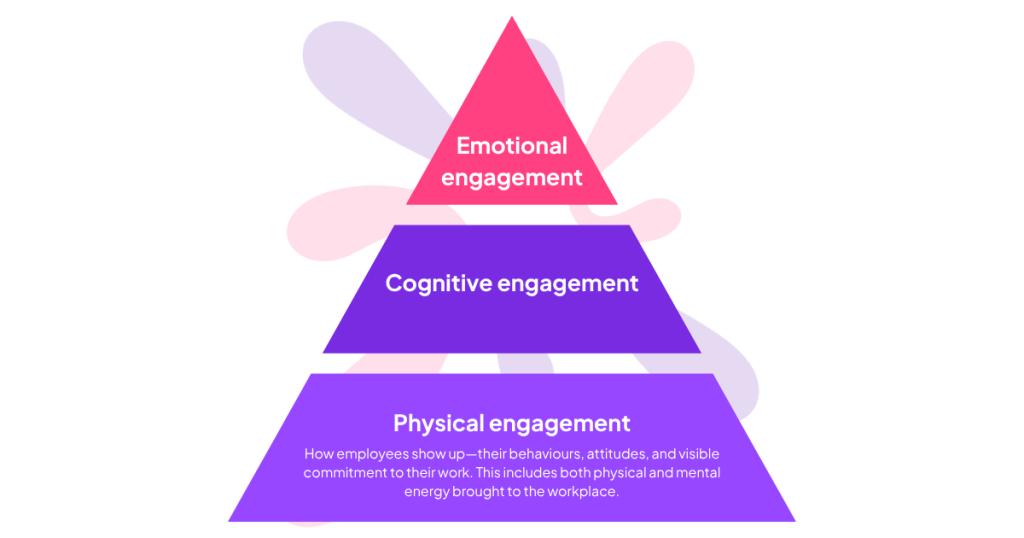
De 12 elementene for medarbeiderengasjement (Gallups Q12-rammeverk)
Gallups vitenskapelig validerte engasjementsundersøkelse for Q12 består av 12 elementer som er bevist å være knyttet til bedre resultater (GallupDisse elementene bygger på hverandre hierarkisk:
Grunnleggende behov:
- Jeg vet hva som forventes av meg på jobb
- Jeg har materialene og utstyret jeg trenger for å gjøre jobben min skikkelig
Individuelt bidrag:
- På jobb har jeg muligheten til å gjøre det jeg er best på hver dag
- I løpet av de siste sju dagene har jeg mottatt anerkjennelse eller ros for å ha gjort en god jobb
- Min overordnede, eller noen på jobben, virker å bry seg om meg som person
- Det er noen på jobben som oppmuntrer meg til utvikling
team~~POS=TRUNC:
- På jobben ser det ut til at meningene mine teller
- Bedriftens oppdrag eller formål får meg til å føle at jobben min er viktig
- Mine medarbeidere er forpliktet til å gjøre et kvalitetsarbeid
- Jeg har en bestevenn på jobb
Vekst:
- I løpet av de siste seks månedene har noen på jobben snakket med meg om fremgangen min
- Det siste året har jeg hatt muligheter på jobben til å lære og vokse
60+ spørsmål til medarbeiderundersøkelse etter kategori
En gjennomtenkt struktur – gruppert etter temaer som direkte påvirker engasjement – bidrar til å avdekke hvor ansatte trives og hvor det finnes blokkeringer (HumlendeHer er kamptestede spørsmål organisert etter viktige engasjementsfaktorer:
Ledelse og administrasjon (10 spørsmål)
Bruk en 5-punkts skala (fra helt uenig til helt enig):
- Min veileder gir tydelige retningslinjer og forventninger
- Jeg har tillit til toppledelsens beslutningstaking
- Ledelsen kommuniserer åpent om endringer i selskapet
- Lederen min gir meg regelmessige, handlingsrettede tilbakemeldinger
- Jeg får den støtten jeg trenger fra min nærmeste overordnede
- Toppledelsen viser at de bryr seg om de ansattes velvære
- Ledelsens handlinger er i samsvar med selskapets uttalte verdier
- Jeg stoler på at sjefen min vil støtte karriereveksten min
- Min veileder anerkjenner og setter pris på mine bidrag
- Lederskap får meg til å føle meg verdsatt som ansatt
Karrierevekst og -utvikling (10 spørsmål)
- Jeg har klare muligheter for avansement i denne organisasjonen
- Noen har diskutert karriereutviklingen min de siste 6 månedene
- Jeg har tilgang til opplæringen jeg trenger for å utvikle meg profesjonelt
- Rollen min hjelper meg med å utvikle ferdigheter som er verdifulle for fremtiden min
- Jeg får meningsfull tilbakemelding som hjelper meg å forbedre meg
- Det er noen på jobb som aktivt veileder eller coacher meg
- Jeg ser en klar vei for utvikling i karrieren min her
- Selskapet investerer i min faglige utvikling
- Jeg har muligheter til å jobbe med utfordrende, vekstorienterte prosjekter
- Lederen min støtter karrieremålene mine, selv om de leder utenfor teamet vårt
Formål og mening (10 spørsmål)
- Jeg forstår hvordan arbeidet mitt bidrar til bedriftens mål
- Selskapets oppdrag får meg til å føle at jobben min er viktig
- Arbeidet mitt er i samsvar med mine personlige verdier
- Jeg føler meg stolt av å jobbe for denne organisasjonen
- Jeg tror på produktene/tjenestene vi leverer
- Mine daglige gjøremål er knyttet til noe større enn meg selv
- Selskapet gjør en positiv forskjell i verden
- Jeg vil anbefale dette selskapet som et flott sted å jobbe
- Jeg gleder meg til å fortelle andre hvor jeg jobber
- Rollen min gir meg en følelse av mestring
Samarbeid og samarbeid (10 spørsmål)
- Mine kolleger er opptatt av å gjøre et kvalitetsarbeid
- Jeg kan stole på støtten til teammedlemmene mine
- Informasjon deles åpent på tvers av avdelinger
- Teamet mitt jobber godt sammen for å løse problemer
- Jeg føler meg komfortabel med å uttrykke meninger i teammøter
- Det er et sterkt samarbeid mellom avdelingene
- Folkene i teamet mitt behandler hverandre med respekt
- Jeg har bygget meningsfulle relasjoner med kolleger
- Teamet mitt feirer suksesser sammen
- Konflikter håndteres konstruktivt i teamet mitt.
Arbeidsmiljø og ressurser (10 spørsmål)
- Jeg har verktøyene og utstyret som trengs for å gjøre jobben min bra
- Arbeidsmengden min er håndterbar og realistisk
- Jeg har fleksibilitet i hvordan jeg utfører arbeidet mitt
- Det fysiske/virtuelle arbeidsmiljøet støtter produktiviteten
- Jeg har tilgang til informasjonen jeg trenger for å gjøre jobben min
- Teknologiske systemer muliggjør snarere enn hindrer arbeidet mitt
- Prosesser og prosedyrer gir mening og er effektive
- Jeg blir ikke overveldet av unødvendige møter
- Ressurser fordeles rettferdig på tvers av teamene
- Selskapet tilbyr tilstrekkelig støtte for fjern-/hybridarbeid
Anerkjennelse og belønninger (5 spørsmål)
- Jeg får anerkjennelse når jeg gjør en utmerket jobb
- Lønn er rettferdig for min rolle og mitt ansvar
- Høypresterende blir belønnet på passende måte
- Mine bidrag verdsettes av ledelsen
- Selskapet anerkjenner både individuelle og teamprestasjoner
Velvære og balanse mellom arbeid og fritid (5 spørsmål)
- Jeg kan opprettholde en sunn balanse mellom jobb og fritid
- Selskapet bryr seg genuint om de ansattes velvære
- Jeg føler meg sjelden utbrent av jobben min
- Jeg har nok fritid til å hvile og lade opp
- Stressnivået i rollen min er håndterbart
Engasjementsindikatorer (utfallsspørsmål)
Disse går i begynnelsen som kjernemålinger:
- På en skala fra 0–10, hvor sannsynlig er det at du vil anbefale dette selskapet som et sted å jobbe?
- Jeg ser for meg at jeg jobber her om to år
- Jeg er motivert til å bidra utover mine grunnleggende jobbkrav
- Jeg tenker sjelden på å søke jobb i andre selskaper
- Jeg er entusiastisk over arbeidet mitt
Hvordan utforme en effektiv medarbeiderundersøkelse
1. Sett klare mål
Før du lager spørsmål, definer:
- Hvilke problemer prøver du å løse?
- Hva skal du gjøre med resultatene?
- Hvem må være involvert i handlingsplanleggingen?
Uten å forstå formålet risikerer organisasjoner å bruke ressurser på spørreundersøkelser uten å oppnå meningsfulle forbedringer (Qualtrics)
2. Hold det fokusert
Retningslinjer for undersøkelseslengde:
- Pulsundersøkelser (kvartalsvis): 10–15 spørsmål, 5–7 minutter
- Årlige omfattende undersøkelser: 30–50 spørsmål, 15–20 minutter
- Inkluder alltid2–3 åpne spørsmål for kvalitativ innsikt
Organisasjoner gjennomfører i økende grad pulsundersøkelser kvartalsvis eller månedlig i stedet for å utelukkende stole på årlige undersøkelser (Qualtrics)
3. Design for ærlighet
Sørg for psykologisk trygghet:
- Avklar konfidensialitet kontra anonymitet på forhånd
- For lag under 5 personer, summer resultatene for å beskytte identiteten
- Tillat anonyme spørsmålsinnsendinger i direkte spørsmål og svar
- Skap en kultur der tilbakemeldinger virkelig er velkomne
Pro tip: Å bruke en tredjepartsplattform som AhaSlides gir et ekstra lag med skille mellom respondenter og ledelse, noe som oppmuntrer til mer ærlige svar.
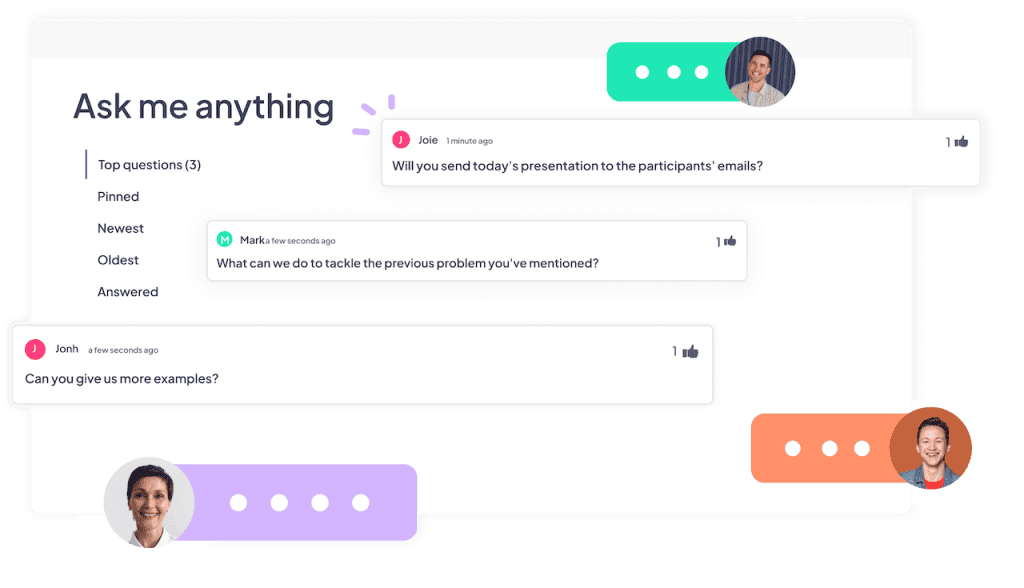
4. Bruk konsistente vurderingsskalaer
Anbefalt skala: 5-punkts Likert
- Sterkt uenig
- Være uenig
- Nøytral
- Enig
- Helt enig
Alternative: Net Promoter Score (eNPS)
- «På en skala fra 0–10, hvor sannsynlig er det at du vil anbefale dette selskapet som arbeidsplass?»
For eksempel kan en eNPS på +30 virke sterk, men hvis den siste undersøkelsen din scoret +45, kan det være problemer som er verdt å undersøke (Humlende)
5. Strukturer undersøkelsesflyten din
Optimal rekkefølge:
- Innledning (formål, konfidensialitet, estimert tid)
- Demografisk informasjon (valgfritt: rolle, avdeling, ansettelsesperiode)
- Kjernespørsmål om engasjement (gruppert etter tema)
- Åpne spørsmål (maks. 2–3)
- Takk + tidslinje for neste steg
6. Inkluder strategiske åpne spørsmål
Eksempler:
- «Hva er én ting vi bør begynne å gjøre for å forbedre opplevelsen din?»
- "Hva er én ting vi burde slutte å gjøre?"
- «Hva fungerer bra som vi bør fortsette med?»
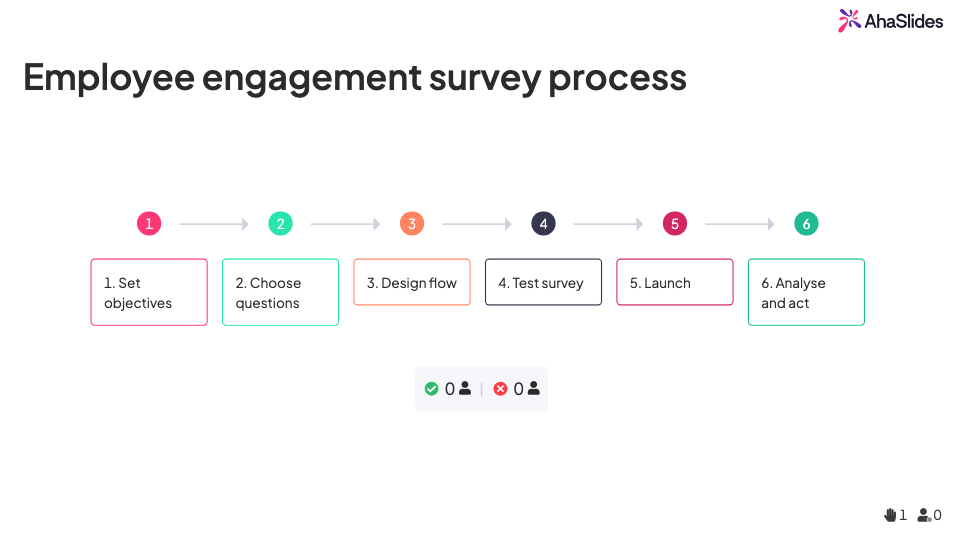
Analysere resultater og iverksette tiltak
Å forstå og handle på tilbakemeldinger fra ansatte er avgjørende for å fremme en blomstrende bedriftskultur (HumlendeHer er rammeverket for handling etter undersøkelsen:
Fase 1: Analysere (uke 1–2)
Se etter:
- Total engasjementspoengsum kontra bransjestandarder
- Kategoripoeng (hvilke dimensjoner er sterkest/svakest?)
- Demografiske forskjeller (er visse team/ansettelsesgrupper betydelig forskjellige?)
- Åpne temaer (hvilke mønstre dukker opp i kommentarene?)
Bruk referansetester: Sammenlign resultatene dine med relevante bransje- og størrelseskategori-benchmarks fra etablerte databaser (Quantum arbeidsplass) for å forstå hvor du står.
Fase 2: Del resultater (uke 2–3)
Åpenhet bygger tillit:
- Del samlede resultater med hele organisasjonen
- Gi resultater på teamnivå til ledere (hvis utvalgsstørrelsen tillater det)
- Anerkjenn både styrker OG utfordringer
- Forplikt deg til en spesifikk tidslinje for oppfølging
Fase 3: Lag handlingsplaner (uke 3–4)
Undersøkelsen er ikke slutten – det er bare begynnelsen. Målet er å starte samtaler mellom ledere og ansatte (ADP)
Framework:
- Identifiser 2–3 prioriterte områder (ikke prøv å fikse alt)
- Dann tverrfaglige handlingsteam (inkludert forskjellige stemmer)
- Sett spesifikke, målbare mål (f.eks. «Øk poengsummen for klar retning fra 3.2 til 4.0 innen Q2»)
- Tildel eiere og tidslinjer
- Kommuniser fremdriften regelmessig
Fase 4: Iverksett tiltak og mål (pågående)
- Implementer endringer med tydelig kommunikasjon
- Gjennomfør pulsmålinger kvartalsvis for å spore fremdriften
- Feir seire offentlig
- Iterer basert på hva som fungerer
Ved å vise ansatte hvordan tilbakemeldingene deres har spesifikk innvirkning, kan organisasjoner øke engasjementet og redusere tretthet i undersøkelser (ADP)
Hvorfor bruke AhaSlides til medarbeiderundersøkelser?
Å lage engasjerende, interaktive undersøkelser som ansatte faktisk ønsker å fullføre krever riktig plattform. Slik forvandler AhaSlides den tradisjonelle undersøkelsesopplevelsen:
1. Engasjement i sanntid
I motsetning til statiske undersøkelsesverktøy, lager AhaSlides interaktive undersøkelser:
- Levende ordskyer å visualisere kollektive følelser
- Sanntidsresultater vises etter hvert som svarene kommer inn
- Anonyme spørsmål og svar for oppfølgingsspørsmål
- Interaktive skalaer som føles mindre som lekser
Bruk tilfelle: Kjør engasjementsundersøkelsen din under et rådhusmøte, og vis anonymiserte resultater i sanntid for å starte en umiddelbar diskusjon.
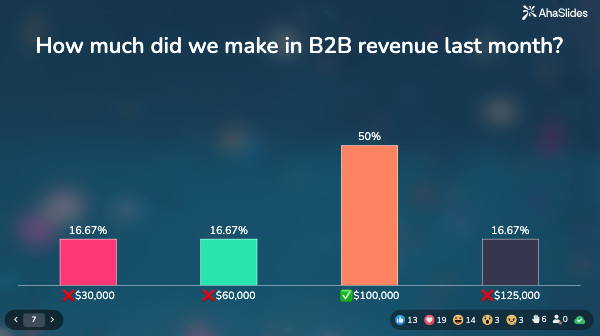
2. Flere responskanaler
Møt ansatte der de er:
- Mobilvennlig (ingen appnedlasting kreves)
- QR-kodetilgang for personlige møter
- Integrasjon med virtuelle møteplattformer
- Alternativer for skrivebord og kiosk for arbeidere uten skrivebord
Resultatet: Høyere deltakelsesrater når ansatte kan svare på sin foretrukne enhet.
3. Innebygde anonymitetsfunksjoner
Ta tak i den største bekymringen i undersøkelsen:
- Ingen innlogging nødvendig (tilgang via lenke/QR-kode)
- Personverninnstillinger for resultater
- Aggregert rapportering som beskytter individuelle svar
- Valgfrie anonyme åpne svar
4. Utviklet for handling
Utover innsamling, kjør resultater:
- Eksporter data til Excel/CSV for dypere analyse
- Visuelle dashbord som gjør resultatene skanbare
- Presentasjonsmodus å dele funn på tvers av teamet
- Spor endringer på tvers av flere runder med undersøkelser
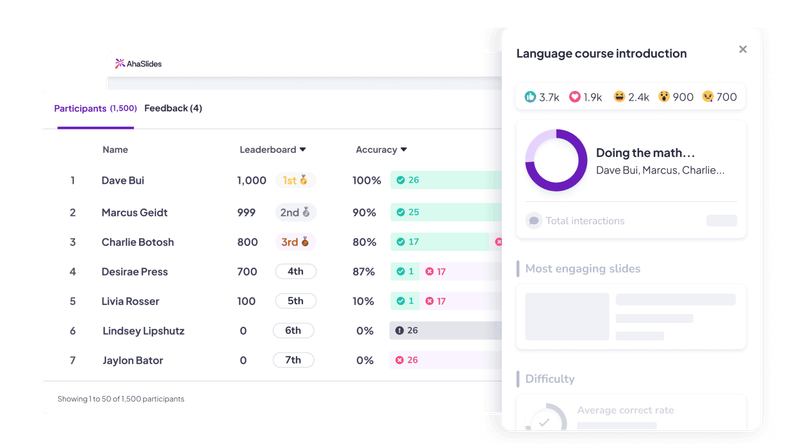
5. Maler for å komme raskt i gang
Ikke start fra bunnen av:
- Forhåndsbygd medarbeiderundersøkelse maler
- Tilpassbare spørsmålsbanker
- Rammeverk for beste praksis (Gallup Q12, osv.)
- Bransjespesifikke modifikasjoner
Vanlige spørsmål om medarbeiderundersøkelser
Hvor ofte bør vi gjennomføre engasjementsundersøkelser?
Ledende organisasjoner går over fra årlige undersøkelser til hyppigere pulsundersøkelser – kvartalsvis eller til og med månedlig – for å holde seg oppdatert på raskt skiftende ansattes holdninger (QualtricsAnbefalt kadens:
+ Årlig omfattende undersøkelse: 30–50 spørsmål som dekker alle dimensjoner
+ Kvartalsvise pulsundersøkelser: 10–15 spørsmål om målrettede emner
+ Hendelsesutløste undersøkelser: Etter større endringer (omorganiseringer, lederskifter)
Hva er en god svarprosent på en engasjementsundersøkelse?
Den høyeste registrerte svarprosenten i organisasjonen var 44.7 %, med et mål om å nå minst 50 % (Washington State University). Bransjestandarder:
+ 60% +: Utmerket
+ 40–60 %: Bra
+ <40 %Bekymringsfull (indikerer mangel på tillit eller undersøkelsestrøtthet)
Øk svarprosenten ved å:
+ Anbefaling fra lederskapet
+ Flere påminnelseskommunikasjoner
+ Tilgjengelig i arbeidstiden
+ Tidligere demonstrasjon av å handle på tilbakemeldinger
Hva bør inkluderes i en struktur for en medarbeiderundersøkelse?
En effektiv undersøkelse inkluderer: innledning og instruksjoner, demografisk informasjon (valgfritt), engasjementserklæringer/spørsmål, åpne spørsmål, ytterligere temamoduler og en konklusjon med en tidslinje for oppfølging.
Hvor lang bør en medarbeiderundersøkelse være?
Medarbeiderundersøkelser kan variere fra 10–15 spørsmål for pulsundersøkelser til 50+ spørsmål for omfattende årlige vurderinger (AhaSlides). Nøkkelen er å respektere de ansattes tid:
+ Pulsundersøkelser: 5–7 minutter (10–15 spørsmål)
+ Årlige undersøkelserMaksimum 15–20 minutter (30–50 spørsmål)
+ Generell regelHvert spørsmål bør ha et klart formål
Klar til å lage din medarbeiderundersøkelse?
Å lage en effektiv medarbeiderundersøkelse er både en kunst og en vitenskap. Ved å følge rammeverkene som er skissert her – fra Gallups Q12-elementer til tematisk spørsmålsdesign til handlingsplanleggingsprosesser – vil du lage undersøkelser som ikke bare måler engasjement, men aktivt forbedrer det.
Husk: Undersøkelsen er bare begynnelsen; det virkelige arbeidet ligger i samtalene og handlingene som følger.
Start nå med AhaSlides:
- Velg en mal - Velg fra forhåndsbygde rammeverk for engasjementsundersøkelser
- Skreddersy spørsmål – Tilpass 20–30 % til organisasjonens kontekst
- Konfigurer live- eller selvstyrt modus - Konfigurer om deltakerne må svare med en gang eller når som helst de kan
- Start - Del via lenke, QR-kode eller legg inn i rådhuset ditt
- Analyser og handle - Eksporter resultater, identifiser prioriteringer, lag handlingsplaner
🚀 Lag din gratis undersøkelse om medarbeiderengasjement
Stolt på av 65 % av verdens beste selskaper og team ved 82 av de 100 beste universitetene i verden. Bli med tusenvis av HR-medarbeidere, trenere og ledere som bruker AhaSlides for å bygge mer engasjerte og produktive team.








